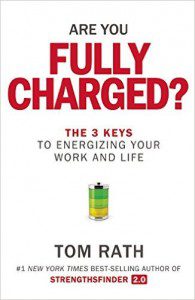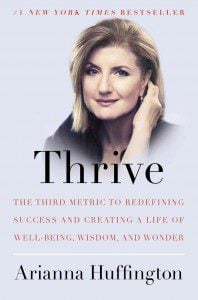Do you know the work of the social scientist and author Tom Rath? I first heard about him about ten years ago through his bestseller How Full Is Your Bucket? There’s also a great children’s version of that book. Over the past decade, he has written six New York Times bestsellers, which have cumulatively sold more than 6 million copies. “He serves as a senior scientist for and advisor to Gallup, where he previously spent thirteen years leading the organization’s work on employee engagement, strengths, leadership, and well-being.”
I am, however, less interested in Rath’s accomplishments than his personal story. When he was 16, a large tumor caused him to lose sight in his left eye. He was diagnosed with a rare genetic condition, which “shuts off a powerful tumor suppressor.” He writes:
My doctors told me I would need to spend a week in the hospital for scans and testing every year for the rest of my life. This allows my physicians to keep track of my cancers — currently growing in my eye, kidneys, pancreas, adrenal glands, and spine — and to operate or try chemotherapy as needed. But if everything goes well, as it has most of the time, I leave the hospital at the end of that week with a fresh 12-month lease on life. Having this extension — with terms that are renewed annually — energizes me to try to make a difference every single day…. It has now been 23 years since my diagnosis. (11-12)
Rath can’t change his genetic condition, but he has dedicated his life to changing what he can: researching how to make the most of the limited time he — or any of us — have. And although most of us don’t have to spend a week annually in the hospital hoping for another year-long lease on life, most of us do have some downtime during the winter holidays, leading up to New Year’s Day, a time for recollection of the past year and resolutions for the new year to come.
Tom Rath’s research and his personal experiences have led him to emphasize the importance of “daily well-being,” focusing on improving the quality of how we spend each day (4). As the writer Annie Dillard says, “How we spend our days is of course how we spend our lives. What we do with this hour and that one is what we are doing” (32). In seeking to increase our well-being, researchers have identified “Five Essential Elements”:
- How you occupy your time or simply liking what you do every day: your Career Well-being
- Having strong relationships and love in your life: your Social Well-being
- Effectively managing your economic life: your Financial Well-being
- Having good health and enough energy to get things done on a daily basis: your Physical Well-being
- The sense of engagement you have with the area where you live: your Community Well-being (6)
Here at the beginning of 2016, I would like to invite you to reflect on how you are (or aren’t) experiencing well-being in each of these areas of your life: Career, Social, Financial, Physical, and Community. As we go, I’ll share a few insights from Rath’s research. I will end each section with a question. I would invite you to notice if one of the areas feels particularly resonant to you or ripe for work in this season of your life.
I should also note that Rath’s books tend to build on one another. So if you would like to continue to explore further on your own, you may want to skip straight to his latest book Are You Fully Charged? which also has a great kid’s version titled The Rechargeables.
further on your own, you may want to skip straight to his latest book Are You Fully Charged? which also has a great kid’s version titled The Rechargeables.
The first area of Career Well-being is about much more than what you do (or don’t do) to earn a paycheck. It’s about whether you find meaning in the way you spend your time each day. The criteria of meaning is key. With all due respect to Thomas Jefferson, research indicates that much more important than “life, liberty, and the pursuit of happiness” is whether we find meaning in our daily lives (13-14).
Career Well-being often turns on whether you are generally engaged or disengaged throughout the day, which is often correlated with whether or not you spend most of your time in activities which allow you to use your strengths—what you are best at and most enjoy doing. Significantly, “engaged workers had similar happiness levels on working and nonworking days” (21). Studies show that most people are content to work 40 – 60 hours/week if they are engaged and find meaning in what they are doing, “while those who do not get to use their strengths get burned out after just 20 hours of work per week” (28).
For me, one takeaway from Rath’s book is the value of working in 45 minute blocks of intense focus with 15 minute breaks in between. If possible, consider putting your phone in “airplane mode and turning off the wifi on your computer during those 45 minute windows to allow uninterrupted work flow (63).
In the coming year, are there ways in which you could more consistently use your strengths each day? How might you improve your Career Well-being? (29)
The second area of Social Well-being is about “having strong relationships and love in your life.” Looking back on 2015, what are the people, places, and things that made you consistently feel connected, energized, grateful, and more fully yourself? Conversely, which people, places, and things made you consistently feel drained, resentful, and inauthentic?
In the coming year, are there ways (even if just incremental) that you could shape your life to have more people, places, and things in your life that increase your Social Well-being and let go of some of those which decrease your Social Well-being?
The third area is Financial Well-being. To share with you just one insight, it turns out that “retail therapy” (trying to increase happiness through buying material objects for ourselves) is fleetingly effective at best. Spending on others has slightly longer-lasting effect. By far the longest-lasting impact on our well-being comes not from material objects, but from experiences with friends and loved ones, which create lasting memories (55).
In the coming year, how might you spend time and money less on material objects and more on cultivating memorable and meaningful experiences with others?
For the fourth area, Rath summarizes three keys to Physical Well-being: Eat, Move, Sleep. In my own life, I’ve found a lot of guidance around eating well from the work of Michael Pollan, whose motto is “Eat food. Not much. Mostly plants.” I recommend his book Food Rules.
For the second part of “Eat, Move, Sleep,” I tend to exercise in the late afternoon or early evening. But a big takeaway for me from Rath’s research is the benefit of a twenty-minute walk in the morning before breakfast. I’ve tried at various points in my life to motivate myself to exercise in the morning, but it’s been difficult to sustain. But I’ve found that I can motivate myself to set a countdown timer for 10 minutes, walk the dogs out the front door, then retrace my path when the timer rings. Even on my busiest days, those twenty minutes make sure I get in at least some exercise. And even just twenty minutes of exercise improves metabolism and has been shown to boost one’s mood for as long as 12 hours afterward (62).
Relatedly, for those of you who like me are not interested in a Fitbit as another piece of technology to keep up with, if you have an iPhone, be sure to tap on the built-in “Health” app (with the heart icon) on your home screen. Whether you know it or not, Apple has already been tracking your steps. (There’s a similar app for Android phones called Google Fit.) My wife Magin and I often find motivation to take a walk after dinner if we find that we haven’t yet reached 10,000 steps that day (136-137). And although I’m not sure if it would work logistically for me, Rath is one of an increasing number of people I have heard about who love using a treadmill desk. Walking at 1.5 miles per hour, Rath often racks up 30,000 steps daily while talking on the phone, writing, etc. (29, 136).
On the third part of “Eat, Move, Sleep,” I am usually pretty good at giving myself permission to sleep at least 8 hours each night, and Rath’s book is a good reminder of that time being well spent: “On average, the best performers slept 8 hours and 36 minutes” (27). A current challenge for me is what Rath calls “Protect your final hour.” It’s tempting for me to check email and social media up to moments before I lie down to sleep.
In the coming year, what shifts might you feel called to make around how you eat, move, and sleep?
Rath’s fifth and final essential element is Community Well-being (6). For many of us, that’s why we are part of a spiritual community.
In the coming year, how do you feel led to connect in community based on your strengths, passions, and interests (104)?
Overall, Rath’s summaries of social scientific research shows us that to become more fully charged and make the most of our limited time, we should focus on three areas:
- cultivate meaning, engaging in activities that have intrinsic value, use our strengths, and help make the world a better place for others
- seek positive interactions that leave us feeling connected, energized, and grateful — while letting go of people, places, and habits that leave us feeling alienated, enervated, and resentful
- increase our energy through choices around how we eat, move, and sleep (7).
In conclusion, I’ll offer one final tip that intrigues me, but that I have not yet tried. Stickk.com is “a free goal-setting platform created by behavioral economists at Yale University.” Their methodology has been proven to increase your chances of reaching your goals by up to three times. The most fascinating option they provide is that if you do not meet your goal, a donation is made to an Anti-charity that supports the opposite side of a highly controversial issue that you care passionately about.
The Rev. Dr. Carl Gregg is a trained spiritual director, a D.Min. graduate of San Francisco Theological Seminary, and the minister of the Unitarian Universalist Congregation of Frederick, Maryland. Follow him on Facebook (facebook.com/carlgregg) and Twitter (@carlgregg).
Learn more about Unitarian Universalism:
http://www.uua.org/beliefs/principles












